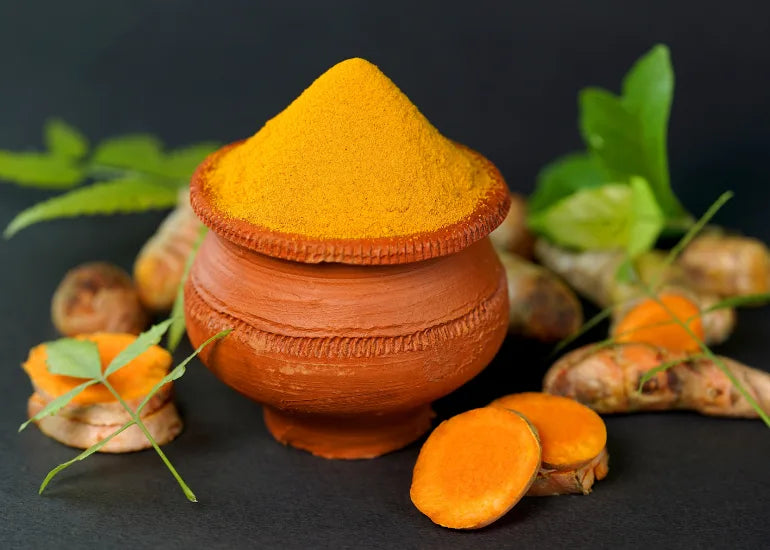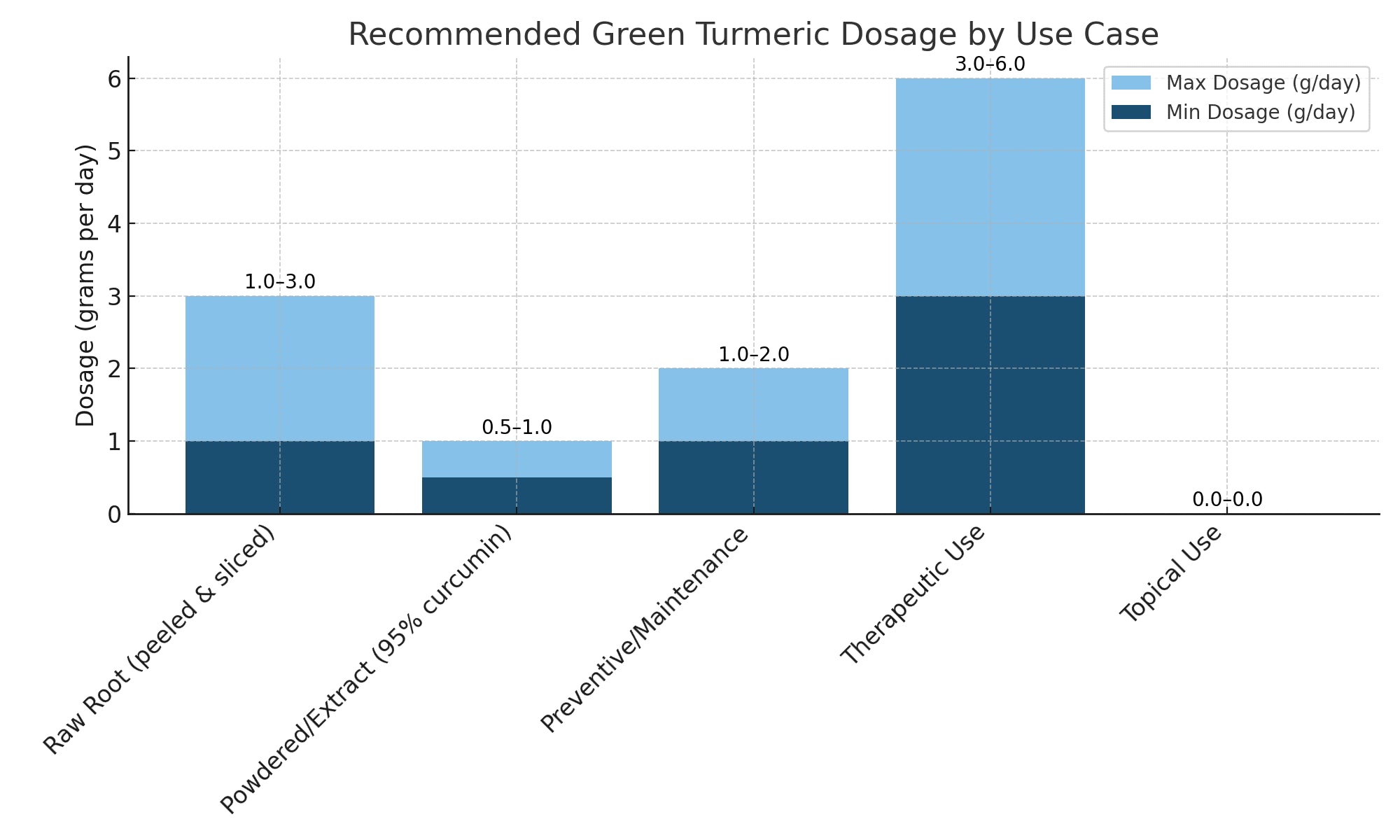
Green turmeric, also known as raw turmeric root, is the fresh, unprocessed form of the turmeric plant (Curcuma longa), harvested before it's cured and dried. While most people are familiar with yellow turmeric powder, green turmeric is the young, vibrant rhizome in its most natural state bright orange inside, encased in a glossy greenish or golden skin.
This raw form contains all the medicinal compounds of turmeric particularly curcumin, turmerones, and essential oils in their most bioavailable and active state. The fresher the turmeric, the higher the potency of these compounds, which tend to degrade with time, heat, and storage.
Green turmeric is typically grown in humid, tropical regions of India and Southeast Asia. The rhizomes are:
Unlike its powdered counterpart, green turmeric is less oxidized, more aromatic, and more pungent, signaling its high concentration of active nutrients.
Green turmeric boasts a broad spectrum of powerful plant compounds, including:
In raw form, the effectiveness of these nutrients is preserved, providing greater therapeutic benefits than highly processed turmeric supplements.
Miduty sources fresh green turmeric that's gently cold-processed to maintain high levels of turmerones, essential oils, curcuminoids, and antioxidants. Unlike many competitors that rely on heat-dried or aged powders losing potency in the process, Miduty's method ensures maximum therapeutic efficacy at cellular level.Studies show green turmeric has higher curcumin absorption due to its natural oil composition . In a synergeticSupergreensblend with healthy fats, spirulina, barley grass, and probiotics, Miduty amplifies turmeric's bioavailability better than isolated turmeric powders.
Green turmeric acts as a powerful alkalizer, balancing the body's pH while aiding detoxification. Alongside other greens like wheatgrass and moringa, it enhances the formula's ability to help reduce acidity, cleanse the liver, and protect against oxidative damage.
Miduty's Supergreens highlights green turmeric for its potent anti-inflammatory and antioxidant benefits supported by clinical research making it especially effective for reducing inflammation, protecting the skin, and enhancing digestion
While fresh turmeric requires peeling or juicing, Miduty's powder is ready-to-use, dissolving easily in water or smoothies. This ensures consistent, everyday use plus it preserves delicate nutrients.
| Uses & Benefits | Description |
| As a Natural Anti-Inflammatory |
Green turmeric is most recognized for its ability to reduce inflammation at the root, making it effective for joint pain and arthritis, muscle soreness, inflammatory bowel disease, skin flare-ups and allergies. Its bioactive compounds, especially curcumin and turmerones, modulate inflammatory pathways like NF-κB and COX-2, providing relief without the side effects of synthetic anti-inflammatory drugs. [1] |
| For Digestive and Liver Health |
Turmeric’s bitter and pungent nature stimulates bile flow, aiding in fat digestion, liver detoxification, and prevention of gallstone formation. [2] Green turmeric also helps reduce bloating, gas, and indigestion, making it a popular remedy in holistic cleansing protocols. |
| Skin and Respiratory Support |
Topically, green turmeric paste can be applied for acne, pigmentation, and scarring, eczema and psoriasis relief, fungal and bacterial infections. Inhaling its vapors or consuming it in warm water may also support sinus decongestion, Cough relief, Respiratory immunity. Its antimicrobial and anti-inflammatory effects make it a multi-functional remedy from skin to lungs. |
| Enhanced Antioxidant and Detox Action |
Green turmeric neutralizes free radicals, detoxifies the liver, and reduces oxidative stress, prevents DNA damage, cleanses heavy metals and pollutants. [3] It activates the body’s own antioxidant defense enzymes like glutathione peroxidase and catalase, giving it broad-spectrum detox support. |
| Supports Joint, Gut, and Immune Health |
The anti-inflammatory effects of green turmeric extend to joint flexibility and cartilage protection, gut lining repair and microbiome balance, immune modulation to prevent chronic infections and allergies. [4] Unlike NSAIDs, green turmeric heals rather than damages the gut lining, making it a safe long-term anti-inflammatory. [2] |

Depending on the form and use case, a general guideline includes:
Always start with a smaller dose if you’re new to turmeric, and increase gradually. Raw turmeric is powerful; a little goes a long way, especially in fresh form.
Green turmeric works best when taken:
Its anti-inflammatory properties are most effective when taken consistently, at the same time each day, to build up curcumin levels in the body.
With or Without Food: Green turmeric can be taken with or without food, though consuming it with healthy fats (like coconut oil, ghee, or nuts) significantly improves curcumin absorption.
For example:
Though generally safe, green turmeric may not be suitable for:
If you're managing a medical condition or taking medication, always consult a healthcare professional before starting turmeric supplementation.
Some people may experience mild reactions when starting green turmeric, such as:
To reduce the risk:
If applying topically, do a patch test first to avoid skin irritation or staining.
Green turmeric is more than a spice it's a multi-functional healing herb that supports:
Whether you're looking for daily detox, natural pain management, or immunity support, green turmeric offers a whole-body upgrade safely, naturally, and effectively.
You can use green turmeric in various easy, delicious ways:
Or simply choose Miduty's Green Turmeric-infused supplements, where quality, potency, and convenience meet in perfect balance.
Yes, green turmeric is beneficial for you, as it contains curcumin, a powerful compound with anti-inflammatory, antioxidant, and antiseptic properties. It supports digestion, may ease pain and inflammation, and may support heart and brain health.
You can use green turmeric in several ways grate or slice it fresh and add to curries, soups, teas, or smoothies for flavor and health benefits. It can also be pickled, juiced, or blended into herbal shots. For best results, pair it with black pepper or healthy fats to enhance curcumin absorption.
Turmeric appears green when it is freshly harvested, as the rhizome has a natural greenish-yellow tint before it dries and matures into the familiar deep yellow-orange powder. Sometimes, exposure to moisture, certain minerals in the soil, or early harvesting can also give turmeric a greener hue. This green turmeric is simply the fresh, raw form of turmeric.
Green turmeric is used both as a spice and in traditional medicine for its anti-inflammatory and antioxidant benefits. It supports digestion, boosts immunity, and may help manage conditions like arthritis, respiratory issues, and liver health. It's also applied topically for pain relief, swelling, and skin care.
Green turmeric offers anti-inflammatory and antioxidant benefits thanks to curcumin, its key compound. It may help ease joint pain, support liver and heart health, improve digestion, and boost immunity. Regular use can also aid brain function, uplift mood, and promote healthy skin.
Yes, green turmeric is edible and is commonly used fresh in cooking, teas, smoothies, and pickles. It adds a slightly earthy, peppery flavor along with health benefits. However, it should be consumed in moderation, as excessive intake may cause stomach discomfort in some people.
